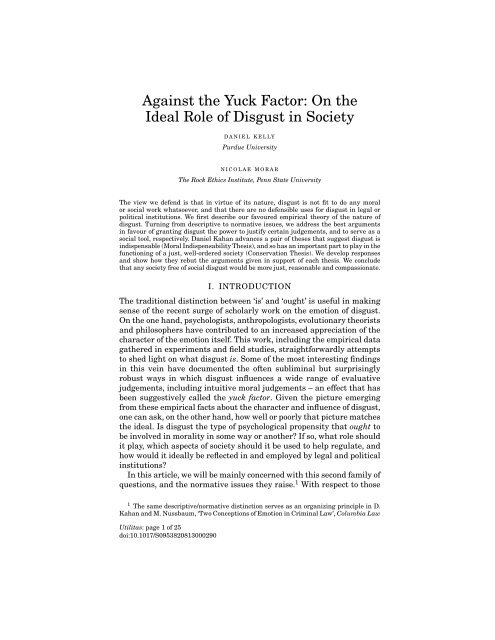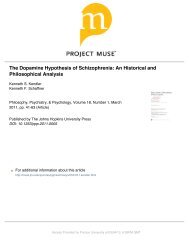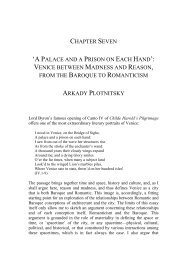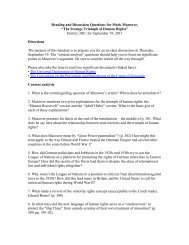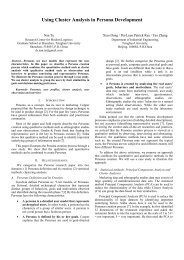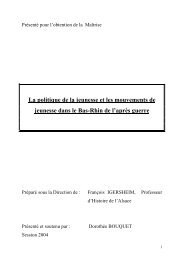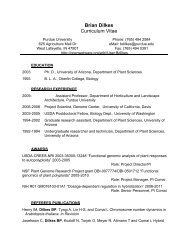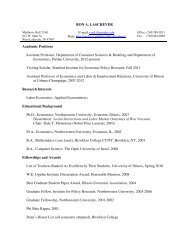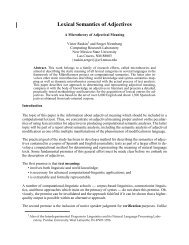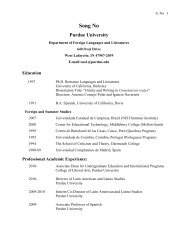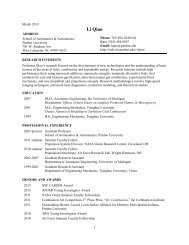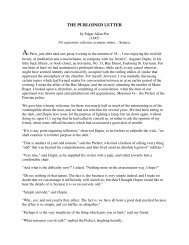Against the Yuck Factor - Career Account Web Pages - Purdue ...
Against the Yuck Factor - Career Account Web Pages - Purdue ...
Against the Yuck Factor - Career Account Web Pages - Purdue ...
Create successful ePaper yourself
Turn your PDF publications into a flip-book with our unique Google optimized e-Paper software.
<strong>Against</strong> <strong>the</strong> <strong>Yuck</strong> <strong>Factor</strong>: On <strong>the</strong><br />
Ideal Role of Disgust in Society<br />
DANIEL KELLY<br />
<strong>Purdue</strong> University<br />
NICOLAE MORAR<br />
The Rock Ethics Institute, Penn State University<br />
The view we defend is that in virtue of its nature, disgust is not fit to do any moral<br />
or social work whatsoever, and that <strong>the</strong>re are no defensible uses for disgust in legal or<br />
political institutions. We first describe our favoured empirical <strong>the</strong>ory of <strong>the</strong> nature of<br />
disgust. Turning from descriptive to normative issues, we address <strong>the</strong> best arguments<br />
in favour of granting disgust <strong>the</strong> power to justify certain judgements, and to serve as a<br />
social tool, respectively. Daniel Kahan advances a pair of <strong>the</strong>ses that suggest disgust is<br />
indispensable (Moral Indispensability Thesis), and so has an important part to play in <strong>the</strong><br />
functioning of a just, well-ordered society (Conservation Thesis). We develop responses<br />
and show how <strong>the</strong>y rebut <strong>the</strong> arguments given in support of each <strong>the</strong>sis. We conclude<br />
that any society free of social disgust would be more just, reasonable and compassionate.<br />
I. INTRODUCTION<br />
The traditional distinction between ‘is’ and ‘ought’ is useful in making<br />
sense of <strong>the</strong> recent surge of scholarly work on <strong>the</strong> emotion of disgust.<br />
On <strong>the</strong> one hand, psychologists, anthropologists, evolutionary <strong>the</strong>orists<br />
and philosophers have contributed to an increased appreciation of <strong>the</strong><br />
character of <strong>the</strong> emotion itself. This work, including <strong>the</strong> empirical data<br />
ga<strong>the</strong>red in experiments and field studies, straightforwardly attempts<br />
to shed light on what disgust is. Someof<strong>the</strong>mostinterestingfindings<br />
in this vein have documented <strong>the</strong> often subliminal but surprisingly<br />
robust ways in which disgust influences a wide range of evaluative<br />
judgements, including intuitive moral judgements – an effect that has<br />
been suggestively called <strong>the</strong> yuck factor. Given<strong>the</strong>pictureemerging<br />
from <strong>the</strong>se empirical facts about <strong>the</strong> character and influence of disgust,<br />
one can ask, on <strong>the</strong> o<strong>the</strong>r hand, how well or poorly that picture matches<br />
<strong>the</strong> ideal. Is disgust <strong>the</strong> type of psychological propensity that ought to<br />
be involved in morality in some way or ano<strong>the</strong>r? If so, what role should<br />
it play, which aspects of society should it be used to help regulate, and<br />
how would it ideally be reflected in and employed by legal and political<br />
institutions?<br />
In this article, we will be mainly concerned with this second family of<br />
questions, and <strong>the</strong> normative issues <strong>the</strong>y raise. 1 With respect to those<br />
1 The same descriptive/normative distinction serves as an organizing principle in D.<br />
Kahan and M. Nussbaum, ‘Two Conceptions of Emotion in Criminal Law’, Columbia Law<br />
Utilitas: page 1 of 25<br />
doi:10.1017/S0953820813000290
2 Daniel Kelly and Nicolae Morar<br />
issues, we aim to defend a simple but fairly extreme position. On <strong>the</strong><br />
view we will advance, <strong>the</strong>re are no defensible uses for disgust in legal<br />
or political institutions. We think that disgust is ill-suited to do any<br />
moral or social work whatsoever, and hold ra<strong>the</strong>r that <strong>the</strong> ideal role for<br />
disgust in such contexts is no role at all.<br />
What such a claim amounts to will take some sorting out. Since our<br />
normative scepticism stems largely from what recent empirical work<br />
has revealed about <strong>the</strong> character of disgust, section II will provide a<br />
brief summary of <strong>the</strong> view of <strong>the</strong> emotion’s nature that will inform<br />
<strong>the</strong> rest of <strong>the</strong> article. Turning next to <strong>the</strong> normative issues, section<br />
III will take a quick tour through some of <strong>the</strong> relevant conceptual<br />
landscape, distinguishing a number of separate roles that advocates of<br />
disgust have argued <strong>the</strong> emotion can and should play. Section IV of <strong>the</strong><br />
article <strong>the</strong>n considers what we take to be <strong>the</strong> toughest challenge to our<br />
normative scepticism, found in <strong>the</strong> work of legal <strong>the</strong>orist Daniel Kahan.<br />
Kahan offers a pair of <strong>the</strong>ses that suggest disgust is indispensable, and<br />
has an important part to play in <strong>the</strong> functioning of a just, well-ordered<br />
society. After describing each <strong>the</strong>sis and showing where it fits with<br />
respect to our taxonomy of possible roles disgust might be granted, we<br />
formulate <strong>the</strong> arguments given in support of it. Then, for each <strong>the</strong>sis<br />
we go on to show where we think <strong>the</strong> arguments fail, often appealing<br />
to relevant features of <strong>the</strong> emotion itself.<br />
II. THE NATURE OF DISGUST: THE E&C VIEW<br />
It seems obvious to us that in order to best address normative questions<br />
raised by disgust, a rich understanding of <strong>the</strong> character of <strong>the</strong> emotion<br />
itself is crucial. Indeed, all participants in <strong>the</strong> relevant ethical debates<br />
espouse one account or ano<strong>the</strong>r of <strong>the</strong> nature of <strong>the</strong> emotion, and so at<br />
least tacitly regard <strong>the</strong> following question as a legitimate and important<br />
one: what is disgust, such that we should or shouldn’t give it credence<br />
in ethical deliberation, judgement and debate, or such that we should<br />
or shouldn’t use it as a social tool? At this point, we are in a much<br />
better position to answer this type of question than we were even<br />
fifteen years ago. Empirical work on disgust has been flourishing, and<br />
researchers from different fields continue to ga<strong>the</strong>r evidence about its<br />
Review 96 (1996), pp. 269–374. They diagnose what <strong>the</strong>y see as inconsistencies in <strong>the</strong> law’s<br />
prescriptions about emotion, and argue that those inconsistencies stem from <strong>the</strong> lack of a<br />
consistent general <strong>the</strong>ory of what emotions are. We are convinced that <strong>the</strong> term ‘emotion’<br />
expresses an extremely heterogeneous category and that <strong>the</strong>re are empirical reasons to<br />
doubt that such a unified <strong>the</strong>ory of emotions will be forthcoming; see P. Griffiths, What<br />
Emotions Really Are: The Problem of Psychological Categories (Chicago, 1997). Ra<strong>the</strong>r,<br />
we suspect that each emotion will have to be examined and assessed on its own, and in<br />
light of its particular character.
<strong>Against</strong> <strong>the</strong> <strong>Yuck</strong> <strong>Factor</strong> 3<br />
nature. Ra<strong>the</strong>r than attempt to describe <strong>the</strong> bulk of that evidence here,<br />
we will save detailed discussion for <strong>the</strong> later sections of <strong>the</strong> article when<br />
specific features of disgust are relevant to our responses to Kahan. Here<br />
we quickly outline what we will call <strong>the</strong> E&C view, an account of <strong>the</strong><br />
general nature of disgust that was motivated by and designed to explain<br />
<strong>the</strong> empirical evidence. 2<br />
The E&C view is so-called because it rests largely on two claims, <strong>the</strong><br />
Entanglement <strong>the</strong>sis and <strong>the</strong> Co-opt <strong>the</strong>sis. The first holds that disgust<br />
is a composite emotion whose two main components originally evolved<br />
to protect against poisons and parasites, respectively. Counterparts<br />
to <strong>the</strong>se two mechanisms can be found in a range of o<strong>the</strong>r animals,<br />
but only in humans did <strong>the</strong>y become entangled with each o<strong>the</strong>r,<br />
functionally integrated to form what is now recognized in modern adult<br />
humans as this single emotion. Different elements of <strong>the</strong> characteristic<br />
disgust response can be traced to <strong>the</strong> adaptive problems raised by<br />
poisons and those raised by parasites. For instance, elements like <strong>the</strong><br />
familiar gaping facial expression, <strong>the</strong> characteristic phenomenology<br />
and associated feeling of nausea can be traced to issues related to<br />
food intake and potential toxins. Likewise, <strong>the</strong> reflex-like impulse to<br />
move quickly away from <strong>the</strong> offending entity, along with an inferential<br />
signature that includes heightened attention, an evaluative tendency<br />
to think of <strong>the</strong> elicitor as dirty or tainted, and an increased sensitivity<br />
to purity and <strong>the</strong> possibility of contamination, can all be traced to<br />
issues related to disease avoidance and potential infection. Widespread<br />
elicitors of disgust, including those that may be universal and innate,<br />
can be traced to <strong>the</strong>se two adaptive problems as well. Prominent<br />
examples include spoiled meat, rotting fruit, and mouldy bread, on<br />
<strong>the</strong> one hand, and common vectors of disease transmission like<br />
decomposing organic material and o<strong>the</strong>r people who bear typical signs<br />
of infection like hacking coughs, profuse sweating, visible sores and<br />
o<strong>the</strong>r kinds of phenotypic abnormalities, on <strong>the</strong> o<strong>the</strong>r. Disgust also<br />
exhibits many features of psychological systems that are encapsulated:<br />
it is easily activated, typically without effort, deliberation or conscious<br />
intent, and once triggered, it tends to run its course and produce <strong>the</strong><br />
full response, regardless of <strong>the</strong> conscious and considered opinions of<br />
<strong>the</strong> person experiencing <strong>the</strong> emotion. Moreover, in light of <strong>the</strong> risks<br />
involved, when this psychological system errs, it understandably tends<br />
toward false positives ra<strong>the</strong>r than false negatives.<br />
The second half of <strong>the</strong> E&C view, <strong>the</strong> Co-opt <strong>the</strong>sis, holds that once<br />
formed, disgust was also co-opted to play a number of additional roles<br />
2 For a full defence of <strong>the</strong> view, see Daniel Kelly, <strong>Yuck</strong>! The Nature and Moral<br />
Significance of Disgust (Cambridge, 2011).
4 Daniel Kelly and Nicolae Morar<br />
in regulating <strong>the</strong> complex system of human social interactions, most<br />
notably roles related to social norms and group membership. The<br />
emotion was available to acquire auxiliary functions like <strong>the</strong>se in part<br />
because of <strong>the</strong> flexibility of its acquisition system, which allows both<br />
individual and social learning to influence what people find disgusting.<br />
This flexibility, in turn, gives rise to <strong>the</strong> patterns of variation found<br />
in what different individuals and groups of people find disgusting.<br />
Variation of this sort manifests in <strong>the</strong> types of cuisine that different<br />
people and cultures enjoy and find repulsive, but, more importantly, it<br />
also manifests in <strong>the</strong> types of norms, values and social practices people<br />
might find disgusting and reject.<br />
Though disgust primarily evolved to protect against poisons and<br />
parasites, <strong>the</strong> E&C view holds that disgust has been brought to bear<br />
on a variety of social issues, in some cases providing <strong>the</strong> motivation to<br />
comply with certain social norms and to punish those who violate <strong>the</strong>m,<br />
and in o<strong>the</strong>r cases providing <strong>the</strong> motivation to avoid interactions with<br />
members of o<strong>the</strong>r social groups, who engage in different practices and<br />
subscribe to a different set of values and norms. In virtue of its flexibility<br />
and susceptibility to learning, a given individual’s disgust system will<br />
be calibrated by her own personal experience, her family and peers,<br />
and her cultural in-group. Thus, her disgust will be directed not just<br />
at ‘exotic’ cuisines and locally salient markers of disease and infection,<br />
but also at those practices, norms and values that <strong>the</strong> cultural ingroup<br />
deems wrong and disgusting, as well as at those people, including<br />
members of cultural out-groups, who embrace <strong>the</strong>m. 3 Since <strong>the</strong>se vary<br />
from group to group and culture to culture, a given individual’s set of<br />
disgust elicitors will be in part a reflection of her social environment,<br />
with its parochial norms and local social divisions, some of which may<br />
be perfectly legitimate and justified, some of which may be odd but<br />
innocuous artefacts of an idiosyncratic past, o<strong>the</strong>rs of which may be<br />
deeply entrenched but unjust and unreasonable never<strong>the</strong>less.<br />
Finally, <strong>the</strong> E&C view holds that though disgust acquired <strong>the</strong>se new<br />
social functions, it did not lose its old ones, or those features that allow it<br />
to protect effectively against poisons and parasites. Norms, values and<br />
sensitivities to group membership that are informed by this particular<br />
3 Joseph Henrich, Steven Heine and Ara Norenzayan begin an important article on<br />
human psychological variation and diversity with a memorable example: ‘In <strong>the</strong> tropical<br />
forests of New Guinea, <strong>the</strong> Etoro believe that for a boy to achieve manhood he must<br />
ingest <strong>the</strong> semen of his elders. This is accomplished through ritualized rites of passage<br />
that require young male initiates to fellate a senior member. In contrast, <strong>the</strong> nearby<br />
Kaluli maintain that male initiation is only properly done by ritually delivering <strong>the</strong> semen<br />
through <strong>the</strong> initiate’s anus, not his mouth. The Etoro revile <strong>the</strong>se Kaluli practices, finding<br />
<strong>the</strong>m disgusting’ (Joseph Henrich, Steven Heine and Ara Norenzayan, ‘The Weirdest<br />
People in <strong>the</strong> World’, Behavioral and Brain Sciences 33 (2010), pp. 61–135, at 61).
<strong>Against</strong> <strong>the</strong> <strong>Yuck</strong> <strong>Factor</strong> 5<br />
emotion will be infused with <strong>the</strong> full cluster of elements comprising <strong>the</strong><br />
disgust response, including <strong>the</strong> vivid phenomenology and elements of<br />
<strong>the</strong> disgust inferential signature. Thus, like o<strong>the</strong>r triggers of disgust,<br />
<strong>the</strong>y will be intuitively experienced and conceptualized as if <strong>the</strong>y<br />
were revolting, dirty, impure and contaminating, whatever <strong>the</strong>ir actual<br />
character.<br />
III. A BRIEF FIELD GUIDE TO YUCK-RELEVANT<br />
NORMATIVE ISSUES<br />
Setting aside <strong>the</strong> descriptive for now, recent debates over <strong>the</strong> proper, or<br />
merely acceptable, social uses of disgust were sparked by <strong>the</strong> work of<br />
Leon Kass 4 and Martha Nussbaum, 5 but <strong>the</strong> discussion has fanned out<br />
to include a number of o<strong>the</strong>rs, who have staked out many interesting<br />
positions on subtly different normative issues. 6 To get a grip on <strong>the</strong><br />
variety of questions that can be asked about <strong>the</strong> proper social and<br />
political uses of disgust, we will divide <strong>the</strong>m into two main families,<br />
and locate different positions in <strong>the</strong> conceptual space by reference<br />
to how a <strong>the</strong>orist might answer each question. While Nussbaum’s<br />
4 L. Kass, ‘The Wisdom of Repugnance’, The New Republic 216.2 (1997),<br />
; L.Kass,Life,<br />
Liberty, and <strong>the</strong> Defense of Dignity: The Challenge to Bioethics (New York, 2002).<br />
5 M. Nussbaum, ‘ “Secret Sewers of Vice”: Disgust, Bodies, and <strong>the</strong> Law’, The Passions<br />
of <strong>the</strong> Law, ed.SusanBandes(NewYork,1999),pp.19–63;Hiding from Humanity:<br />
Disgust, Shame, and <strong>the</strong> Law (Princeton, 2004); ‘Danger to Human Dignity: The Revival<br />
of Disgust and Shame in <strong>the</strong> Law’, The Chronicle of Higher Education 50.48 (2004), p. B6;<br />
‘Replies’, Journal of Ethics 10 (2006), pp. 463–506; From Disgust to Humanity: Sexual<br />
Orientation and Constitutional Law (Oxford, 2010).<br />
6 For instance, see J. Kekes, ‘Disgust and Moral Taboos’, Philosophy, 67 (1992), pp.<br />
431–46; K. Abrams, ‘Fighting Fire with Fire: Rethinking <strong>the</strong> Role of Disgust in Hate<br />
Crimes’, California Law Review 90 (2002), pp. 1423–64; K. Kulinowski, ‘Nanotechnology:<br />
From “Wow” to “<strong>Yuck</strong>” ’, Bulletin of Science, Technology & Society 24 (2004), pp. 13–20; J.<br />
Raikka and K. Rossi, ‘Bioethics and The Moral Significance of “Gut Feelings” ’, Türkiye<br />
Klinikleri Journal of Medical Ethics, Law and History 12 (2004), pp. 79–82; L. Turner,<br />
‘Is Repugnance Wise? Visceral Responses to Biotechnology’, Nature Biotechnology 22<br />
(2004), pp. 269–70; A. D. N. J. de Grey, ‘Life Extension, Human Rights, and <strong>the</strong> Rational<br />
Refinement of Repugnance’, Journal of Medical Ethics, 31(2005),pp.659–63;J.Deigh,<br />
‘The Politics of Disgust and Shame’, Journal of Ethics 10 (2006), pp. 383–418; M.<br />
Hauskeller, ‘Moral Disgust’, Ethical Perspectives: Journal of European Ethics Network<br />
13 (2006), pp. 571–602; R. Arneson, ‘Shame, Stigma, and Disgust in <strong>the</strong> Decent Society’,<br />
The Journal of Ethics 11 (2007), pp. 31–63; J. Douard, ‘Loathing <strong>the</strong> Sinner, Medicalizing<br />
<strong>the</strong> Sin: Why Sexually Violent Predator Statutes are Unjust’, International Journal of<br />
Law and Psychiatry 30 (2007), pp. 36–48; G. Kaebnick, ‘Reasons of <strong>the</strong> Heart Emotion,<br />
Rationality, and <strong>the</strong> “Wisdom of Repugnance” ’, Hastings Center Report 38 (2008), pp.<br />
36–45; J. Niemela, ‘What put <strong>the</strong> “<strong>Yuck</strong>” in <strong>the</strong> <strong>Yuck</strong> <strong>Factor</strong>?’, Bioethics 25 (2010), pp.<br />
267–79. As many of <strong>the</strong>se authors point out, <strong>the</strong> interest in disgust has deeper historical<br />
roots; for instance see P. Devlin, The Enforcement of Morals (Oxford, 1965). In this article,<br />
we focus on Kahan not just for clarity and ease of exposition, but because we think he<br />
has given <strong>the</strong> best and most worked out arguments in favour of <strong>the</strong> normative value of<br />
disgust.
6 Daniel Kelly and Nicolae Morar<br />
work approaches comprehensiveness, not every participant in <strong>the</strong><br />
conversation explicitly states a view on every normative issue, and<br />
an individual <strong>the</strong>orist might take a position on one question while<br />
remaining silent or agnostic on o<strong>the</strong>rs.<br />
The first is what we will call <strong>the</strong> Justification question: should<br />
feelings of disgust, in and of <strong>the</strong>mselves, be taken to help justify <strong>the</strong><br />
judgements that <strong>the</strong>y influence? What sort of role should feelings of<br />
disgust play in debate, deliberation and considered social and moral<br />
judgements, and how should yuck-influenced attitudes be reflected in<br />
explicit social norms and handled by formalized institutions? These<br />
questions about <strong>the</strong> moral epistemology of disgust focus on <strong>the</strong> question<br />
of what, if any, justificatory value <strong>the</strong> emotion should be granted, and<br />
have loomed large in a number of recent debates in different areas of<br />
applied ethics, including environmental ethics, sexual morality and<br />
bioethics. 7 Some, most prominently Kass, have strongly advocated<br />
disgust, claiming that <strong>the</strong> emotion is (perhaps uniquely) sensitive to<br />
ethically important boundaries, and argued that feelings of disgust<br />
can and should help justify <strong>the</strong> moral condemnation of practices that<br />
elicit <strong>the</strong>m. On this view, <strong>the</strong> law ought to prohibit practices that elicit<br />
widespread disgust. O<strong>the</strong>rs are equally as sceptical, arguing that in<br />
systematically assessing <strong>the</strong> moral status of various practices or <strong>the</strong><br />
norms that govern <strong>the</strong>m, feelings of disgust are irrelevant at best,<br />
distracting and misleading at worst. 8<br />
The second is what we will call <strong>the</strong> Admissible Social Tool question.<br />
This question has a slightly different emphasis than <strong>the</strong> first. The<br />
Justification question takes <strong>the</strong> feelings of disgust it is concerned with<br />
as given; <strong>the</strong>presenceofthosefeelingsiswhatraises<strong>the</strong>questionin<br />
<strong>the</strong> first place. For instance, a version of <strong>the</strong> Justification question<br />
would begin with an assumption that <strong>the</strong>re is widespread disgust<br />
towards a social practice like human cloning, and go on to ask how<br />
different institutions should react to or take account of <strong>the</strong> presence<br />
of those feelings, whe<strong>the</strong>r and how <strong>the</strong> deliberative machinery of <strong>the</strong><br />
law should be sensitive to <strong>the</strong>m, or whe<strong>the</strong>r <strong>the</strong>y should be granted<br />
<strong>the</strong> power to justify judgements influenced by <strong>the</strong>m. The Admissible<br />
Social Tool question, on <strong>the</strong> o<strong>the</strong>r hand, asks whe<strong>the</strong>r and when disgust<br />
towards certain objects should be actively cultivated. If disgust is not<br />
just tractable, but an acceptable response to certain practices and<br />
attitudes, <strong>the</strong>n social institutions might take a more active hand in<br />
7 See e.g. M. Midgley, ‘Biotechnology and Monstrosity: Why We Should Pay Attention<br />
to <strong>the</strong> “Yuk <strong>Factor</strong>” ’, The Hastings Center Report 30 (2000), pp. 7–15; Kass, Life,<br />
Liberty, and <strong>the</strong> Defense of Dignity; A. Salles and de Melo-Martin, ‘Disgust in Bioethics’,<br />
Cambridge Quarterly of Healthcare Ethics 21 (2012), pp. 267–80.<br />
8 See e.g. Nussbaum, Hiding from Humanity and Kelly, <strong>Yuck</strong>!.
<strong>Against</strong> <strong>the</strong> <strong>Yuck</strong> <strong>Factor</strong> 7<br />
doing that cultivating, intervening to direct people’s disgust at specific<br />
social objects, with <strong>the</strong> ultimate aim of realizing certain morally and<br />
socially desirable ends.<br />
For instance, policies and o<strong>the</strong>r resources might be designed to<br />
mobilize and direct widespread feelings of disgust towards unwanted<br />
practices, in an attempt to influence public opinion, affect behaviour,<br />
and ultimately reduce or eliminate <strong>the</strong> relevant practices. Paul Rozin<br />
calls this phenomenon moralization, andclaimsthatpracticeslike<br />
smoking, taking drugs, and even unhealthy eating have become moralized<br />
in this sense, and thus objects of disgust, for many segments of<br />
<strong>the</strong> population. Rozin argues that this, in turn, has played a role in <strong>the</strong><br />
gradual decline of those practices. 9 Given <strong>the</strong> yuck factor’s non-trivial<br />
effects on judgement and behaviour, toge<strong>the</strong>r with disgust’s flexibility<br />
and sensitivity to social influence, <strong>the</strong>orists or policymakers could be<br />
tempted to go a step fur<strong>the</strong>r, seeing <strong>the</strong> emotion as a potent tool that can<br />
and should be harnessed to help shape a society, and used to bring about<br />
targeted social change. The basic normative question at issue for <strong>the</strong><br />
Admissible Social Tool question is whe<strong>the</strong>r or not this is correct. Should<br />
disgust be used like this? Should it be cultivated and aimed at objects<br />
in <strong>the</strong> social domain? Is disgust ever an appropriate response to moral<br />
wrongdoing, or is <strong>the</strong>re something about disgust itself, independent of<br />
<strong>the</strong> moral status of its potential uses, and apart from <strong>the</strong> types of social,<br />
legal or political ends that it might be used to serve, which renders it<br />
problematic as a response to transgressions, and thus unfit as a tool to<br />
sway public opinion and influence practices in this way?<br />
An affirmative answer to this question, it should be noted, presumes<br />
that disgust is a morally acceptable response to some range of practices<br />
or transgressions. Imagine Sasha, who is disgusted when she witnesses<br />
an episode of flagrant sexism, and loudly and correctly condemns it. One<br />
issue is whe<strong>the</strong>r Sasha’s judgement that <strong>the</strong> sexism was morally wrong<br />
is all or in part justified by her feelings of disgust. (Someone sceptical<br />
about disgust’s justificatory value could accept that <strong>the</strong> judgement is<br />
indeed justified, but still deny that Sasha’s disgust reaction has any<br />
part to play in its justification.) Ano<strong>the</strong>r issue is whe<strong>the</strong>r Sasha’s<br />
reaction of disgust is an acceptable way to respond to <strong>the</strong> episode<br />
of sexism. Even granting that <strong>the</strong> sexist himself exhibits a serious<br />
moral failing, some responses to that episode will be morally acceptable<br />
(loudly condemning it, for instance), while o<strong>the</strong>rs will clearly not be<br />
(perpetrating immediate and devastating physical violence on <strong>the</strong><br />
offender, for instance). But what should we make of Sasha’s disgust<br />
at <strong>the</strong> episode? Does it belong to <strong>the</strong> former or latter category? Is it<br />
9 P. Rozin, ‘The Process of Moralization’, Psychological Science 10 (1999), pp. 218–21.
8 Daniel Kelly and Nicolae Morar<br />
something of which she should be proud, something to be celebrated<br />
and emulated, or something that a moral exemplar would see as a lapse<br />
or shortcoming, and rightly aspire to overcome?<br />
This issue also has ramifications for how formalized legal<br />
mechanisms of punishment are assessed. A <strong>the</strong>orist who holds<br />
that disgust is a morally acceptable response could argue that <strong>the</strong><br />
emotion can and should be used by <strong>the</strong> law as a tool for certain<br />
retributive purposes. Different kinds of transgressions elicit different<br />
types of reactions, and deserve different kinds of punishments.<br />
Perhaps an acceptable reaction to some of <strong>the</strong> most extreme kinds of<br />
transgressions is disgust, and perhaps a society and its institutions can<br />
justifiably impose punishments that purposefully invoke <strong>the</strong> emotion.<br />
By way of analogy, shame-based punishments are designed to use<br />
aspecificemotionforretributivepurposes; 10 perhaps an analogous<br />
class of disgust-based punishments that operate by actively making<br />
transgressors into objects of <strong>the</strong> public’s disgust should be available<br />
as well. Indeed, <strong>the</strong> threat of punishments that invoke this specific<br />
emotion could serve as an effective deterrent, helping to fortify <strong>the</strong><br />
legal arsenal. Once again, <strong>the</strong> question at issue is: should a society<br />
put disgust to such uses? Is <strong>the</strong>re anything about <strong>the</strong> character of<br />
this emotion in particular, as opposed to o<strong>the</strong>rs such as shame, guilt<br />
or compassion, that renders it an ill-suited or unacceptable tool for<br />
rendering such psychologically potent punishments?<br />
IV. CHALLENGES TO DISGUST SCEPTICISM<br />
In this section, we focus on <strong>the</strong> view of Daniel Kahan, in whose work<br />
we find <strong>the</strong> clearest and most forceful challenge to our scepticism.<br />
Kahan’s view draws on <strong>the</strong> account of <strong>the</strong> nature of disgust set out<br />
by legal scholar and cultural historian William Miller in his book The<br />
Anatomy of Disgust, 11 about which we will say more below. In general,<br />
Kahan believes this account helps to ‘vindicate <strong>the</strong> normative value<br />
of disgust in criminal law’. 12 He defends two main claims, which he<br />
dubs <strong>the</strong> Conservation <strong>the</strong>sis and <strong>the</strong> Moral Indispensability <strong>the</strong>sis,<br />
respectively. In what follows we describe each <strong>the</strong>sis, locate it in <strong>the</strong><br />
conceptual landscape we sketched in section III, and go on to spell out<br />
<strong>the</strong> argumentative strategy that Kahan uses to support it. We <strong>the</strong>n<br />
say why we reject <strong>the</strong> <strong>the</strong>sis, and show where we think <strong>the</strong> associated<br />
arguments go wrong.<br />
10 See e.g. Joseph Tybor, ‘Unusually Creative Judges Now Believe Some Punishments<br />
Can Fit’, Chicago Tribune, 3July1988.<br />
11 W. Miller, The Anatomy of Disgust (Cambridge, 1997).<br />
12 D. Kahan, ‘The Progressive Appropriation of Disgust’, The Passions of <strong>the</strong> Law, ed.<br />
Susan Bandes (New York, 1999), pp. 63–79, at 64.
<strong>Against</strong> <strong>the</strong> <strong>Yuck</strong> <strong>Factor</strong> 9<br />
Kahan’s Conservation <strong>the</strong>sis<br />
The first important claim defended by Kahan concerns <strong>the</strong> usefulness<br />
of disgust in a just, well-ordered society. The basic idea behind <strong>the</strong><br />
<strong>the</strong>sis is that we are ‘stuck’ with disgust: <strong>the</strong> emotion is a practically<br />
ineliminable part of human nature, and it is also irrepressibly social<br />
in its orientation. It is here to stay, and it will inevitably be directed<br />
at someone. Inlightofthis,weshouldstopchasing<strong>the</strong>unattainable,<br />
potentially damaging ideal of a completely disgust-free society, and<br />
stop kidding ourselves about <strong>the</strong> prospects for totally eradicating <strong>the</strong><br />
emotion from <strong>the</strong> realm of politics and law. Attempts at full removal<br />
will backfire, pushing disgust below <strong>the</strong> surface of more rational,<br />
formalized institutions. This, in turn, will allow disgust to thrash<br />
around unsupervised and uncontrolled by society, and inadvertently<br />
cedes a powerful tool to those shadowy forces that operate outside<br />
institutions and public scrutiny. Instead, society should cultivate, direct<br />
and use disgust to help achieve well-thought out, just social goals.<br />
For instance, Kahan writes that ‘disgust inevitably persists,<br />
notwithstanding shifts in social norms’, 13 and so whe<strong>the</strong>r we explicitly<br />
accept or reject it, it will always somehow inform <strong>the</strong> way we respond to<br />
criminal action. However high minded and well-intentioned, efforts to<br />
eradicate <strong>the</strong> emotion ‘don’t genuinely purge <strong>the</strong> law of disgust. They<br />
only push disgust down below <strong>the</strong> surface of law, where its influence is<br />
harder to detect.’ 14 Instead of fighting against an emotion we cannot<br />
get rid of, we would be better off to use it as a tool in <strong>the</strong> service of<br />
whatever legitimate ends we ultimately settle upon. He recommends<br />
that we press <strong>the</strong> emotion into service, and ‘make disgust a progressive<br />
ra<strong>the</strong>r than a reactionary force’ 15 in order to help us ‘come to value<br />
what is genuinely high and to despise what is genuinely low’. 16 Since<br />
<strong>the</strong>y cannot be completely eradicated, feelings of disgust should be<br />
controlled, shaped and directed.<br />
Cast within our taxonomy of normative issues, we understand <strong>the</strong><br />
Conservation <strong>the</strong>sis as expressing a position on what we called <strong>the</strong><br />
Admissible Social Tool question. The <strong>the</strong>sis provides a straightforward<br />
answer: yes, disgust is a morally acceptable response to certain<br />
practices, attitudes and extreme transgressions, and is a powerful tool<br />
that a just, well-ordered society can and should put to use. We interpret<br />
<strong>the</strong> argumentative structure offered in support of <strong>the</strong> Conservation<br />
13 Kahan, ‘The Progressive Appropriation of Disgust’, p. 69.<br />
14 Kahan, ‘The Progressive Appropriation of Disgust’, p. 72. Kahan suggests that a<br />
historical analysis would show that ‘all societies inevitably make use of disgust to inform<br />
<strong>the</strong>ir judgments of high and low, worthy and unworthy’ (p. 64).<br />
15 Kahan, ‘The Progressive Appropriation of Disgust’, p. 73.<br />
16 Kahan, ‘The Progressive Appropriation of Disgust’, p. 71 (italics in original).
10 Daniel Kelly and Nicolae Morar<br />
<strong>the</strong>sis as follows. It begins with a description of disgust and some<br />
of its more relevant features, i.e. that it is a component of human<br />
nature, an element of <strong>the</strong> species-typical psychological repertoire, and<br />
that <strong>the</strong> emotion is not completely malleable, but is ra<strong>the</strong>r resistant<br />
to radical change in important ways. Most significantly, we cannot,<br />
via act of individual will or reorganization of social arrangements or<br />
institutional structure, completely turn off our disgust, eradicate <strong>the</strong><br />
emotion from <strong>the</strong> human motivational pallet altoge<strong>the</strong>r, or even just<br />
hermetically seal it off from <strong>the</strong> social arena. From this description,<br />
Kahan draws <strong>the</strong> normative conclusion that we should not completely<br />
ignore or abandon disgust, reject it as a political tool, or aspire to<br />
construct our institutions such that <strong>the</strong>y have no grip or purchase on it.<br />
Since it will tend to force itself into <strong>the</strong> social arena, we should aspire to<br />
cultivate and control it, and control it in a specific way, namely by using<br />
it to make targeted types of social change, and strategically directing<br />
feelings of disgust towards unwanted attitudes and practices, as well<br />
as <strong>the</strong> people associated with <strong>the</strong>m.<br />
A sceptical response to <strong>the</strong> Conservation <strong>the</strong>sis<br />
Our primary concern is with normative issues, with what is ideal,<br />
ra<strong>the</strong>r than what actually is, but we also acknowledge that at anything<br />
but <strong>the</strong> most abstract <strong>the</strong>oretical level, <strong>the</strong> relationship between <strong>the</strong><br />
ideal and <strong>the</strong> actual is complicated (perhaps no ‘ought’ can be derived<br />
from an ‘is’, but perhaps ‘ought’ also implies ‘can’ 17 ). However, we do<br />
think that even if it is not within our power fully or immediately to meet<br />
some ideal, it does not straightforwardly follow that <strong>the</strong> ideal itself is<br />
misguided, or should be discarded, or that we should not try to get as<br />
close as we can to achieving it.<br />
That said, we simply concede that, in broad strokes, we agree with<br />
many of <strong>the</strong> empirical claims, and speculative modal claims, on which<br />
Kahan rests his Conservation <strong>the</strong>sis. 18 We find it plausible, based on a<br />
wealth of recent work and our own experience, that disgust certainly<br />
influences a variety of normative judgements and social dynamics,<br />
including <strong>the</strong> sorts on which Kahan focuses. 19 We also find plausible <strong>the</strong><br />
idea that, for better or for worse, we are simply stuck with <strong>the</strong> emotion,<br />
17 See, e.g. W. S. Armstrong, ‘ “Ought” conversationally implies “can” ’, The<br />
Philosophical Review 93 (1984), pp. 249–61.<br />
18 Since Kahan is working with a different and generally more plausible account of <strong>the</strong><br />
character of disgust, different arguments than those made against advocates like Kass<br />
are needed to rebut Kahan’s normative conclusions. See, Kelly, <strong>Yuck</strong>!, pp.137–52.<br />
19 See e.g. H. Chapman and A. Anderson, ‘Things Rank and Gross in Nature: A Review<br />
and Syn<strong>the</strong>sis of Moral Disgust’, Psychological Bulletin 139.2 (2013), pp. 300–27. See<br />
also May, ‘Does Disgust Influence Moral Judgment?’, Australasian Journal of Philosophy<br />
(DOI: 10.1080/00048402.2013.797476) for some doubts about a few of <strong>the</strong> earliest and<br />
most cited experiments, though.
<strong>Against</strong> <strong>the</strong> <strong>Yuck</strong> <strong>Factor</strong> 11<br />
and Kahan is right to call attention to its irrepressibly social character.<br />
Finally, for <strong>the</strong> sake of argument we will grant a presumption of both<br />
<strong>the</strong> Admissible Social Tool question and Kahan’s Conservation <strong>the</strong>sis,<br />
namely that disgust’s flexibility and susceptibility to social influence<br />
make it tractable enough to be considered a potential tool, something<br />
that can be harnessed, directed at specific social targets, put to our<br />
considered purposes. 20<br />
Even so, we remain unconvinced of <strong>the</strong> normative conclusions<br />
Kahan draws from <strong>the</strong>se claims. While he recommends disgust as an<br />
admissible social tool, we remain sceptical: we do not think that disgust<br />
is ever a morally acceptable response to practices, attitudes or people,<br />
and so we do not think <strong>the</strong> emotion is ever <strong>the</strong> right kind of tool for<br />
formalized use in social or legal institutions, nor should it be cultivated<br />
by a society or actively directed at anybody.<br />
We have two arguments against Kahan’s Conservation <strong>the</strong>sis. The<br />
first is that disgust dehumanizes. Nussbaumhasstressedthispoint,<br />
emphasizing <strong>the</strong> long history of this particular emotion’s role in<br />
stigmatization, prejudice and oppression. For <strong>the</strong> purposes of this<br />
article, we make <strong>the</strong> same hopefully uncontroversial assumption<br />
that dehumanization is morally wrong. Moreover, we believe recent<br />
empirical research on disgust provides <strong>the</strong> materials for a stronger<br />
argument. This research shows that in addition to <strong>the</strong> horrible ends to<br />
which it has been put in <strong>the</strong> past, <strong>the</strong> connection between disgust and<br />
dehumanization is not merely an artefact or historical accident, but<br />
flows from <strong>the</strong> nature and operation of <strong>the</strong> emotion itself. For instance,<br />
psychological studies have shown how people in <strong>the</strong> grip of disgust<br />
are much less responsive to o<strong>the</strong>r people’s intentions and to <strong>the</strong>ir very<br />
agency. 21 Evidence from cognitive neuroscience supports this and fills<br />
in details, revealing a link between disgust and dehumanization at a<br />
neural level. The psychology of prejudice can take many forms, but<br />
in those cases where disgust was involved, and only in those cases,<br />
higher brain areas associated with social cognition and <strong>the</strong> recognition<br />
of agency in o<strong>the</strong>rs (<strong>the</strong> medial prefrontal cortex or MPFC) show<br />
20 Which is not to say we are without reservations about this claim. Our worries<br />
stem from <strong>the</strong> fact that disgusting things are naturally conceived as contaminated and<br />
contaminating, and so polluting to anything with which <strong>the</strong>y come into physical (or even<br />
symbolic) contact. Because of this, we suspect disgust will be difficult to contain, or aim<br />
with any degree of precision. In light of this, we think it a dubious idea to put so unreliable<br />
an instrument at anyone’s disposal: a tool that cannot be controlled is a bad tool.<br />
21 L. Young and R. Saxe, ‘When Ignorance is no Excuse: Different Roles for Intent across<br />
Moral Domains’, Cognition 120 (2011), pp. 202–14; P. Russell and R. Giner-Sorolla, ‘Moral<br />
Anger, but Not Moral Disgust, Responds to Intentionality’, Emotion 11 (2011), pp. 233–40.<br />
See also, G. Hodson and K. Costello, ‘Interpersonal Disgust, Ideological Orientations, and<br />
Dehumanization as Predictors of Intergroup Attitude’, Psychological Science 18 (2007),<br />
pp. 691–8 for more on disgust and dehumanization.
12 Daniel Kelly and Nicolae Morar<br />
dramatically reduced activity. 22 An individual who becomes an object<br />
of disgust is difficult to conceive of and treat as fully human, and may<br />
even be denied status as a person. 23<br />
This evidence fits comfortably with <strong>the</strong> E&C view of <strong>the</strong> nature<br />
of disgust, which can also provide some illuminating context. Recall<br />
that according to <strong>the</strong> E&C view, though it easily gets pulled in social<br />
dynamics, disgust is not a typical ‘social’ emotion like, for instance,<br />
love, sympathy, envy or guilt. It did not originate in <strong>the</strong> face of adaptive<br />
problems connected to reciprocity, commitment or cooperation, or to<br />
help navigate Machiavellian social dynamics of defection and deceit.<br />
In light of this, it is not completely surprising that disgust is not<br />
as intrinsically attuned to social cues that carry information about<br />
motivation, intentionality and agency as those more typically social<br />
emotions. The E&C view depicts disgust as having evolved to deal<br />
with poisons and parasites, and when it was co-opted into <strong>the</strong> social<br />
domain it retained much of its original character. That character is<br />
evident not just in <strong>the</strong> emotion’s lack of sensitivity to agency-relevant<br />
cues, but also in <strong>the</strong> elements of <strong>the</strong> disgust response, whose core is<br />
relatively constant across different kinds of elicitors. The elements of<br />
<strong>the</strong> response – <strong>the</strong> gape face, <strong>the</strong> instinctive withdrawal, <strong>the</strong> motivation<br />
to avoid, <strong>the</strong> flash of nausea, <strong>the</strong> inferential signature that creates a<br />
sense of offensiveness and worries about contamination and taint –<br />
are activated by whatever triggers a genuine disgust response, be that<br />
refuse on a hot humid day, a vivid description of a grotesque murder,<br />
or <strong>the</strong> members of a particular out-group like <strong>the</strong> strident adherents of<br />
apoliticalideologyanti<strong>the</strong>ticaltoyourown.<br />
This illustrates ano<strong>the</strong>r way in which disgust dehumanizes, and so<br />
lends fur<strong>the</strong>r support to our scepticism that disgust is ever a laudable<br />
response to a transgression, or that it should be admissible as a<br />
social tool. Disgust does indeed provide strong avoidance motivation,<br />
and can infuse moral condemnation with a singular kind of vividness<br />
and urgency. However, <strong>the</strong>se potential virtues are not sold separately<br />
from <strong>the</strong> rest of <strong>the</strong> elements of <strong>the</strong> response. Disgust, by its very<br />
nature, inevitably brings o<strong>the</strong>r psychological components to bear as<br />
well: <strong>the</strong> propensity to project contamination, pollution, taint and<br />
dirtiness. As noted above, many of <strong>the</strong>se features of <strong>the</strong> response are<br />
22 L. T. Harris and S. T. Fiske, ‘Dehumanizing <strong>the</strong> Lowest of <strong>the</strong> Low: Neuro-imaging<br />
Responses to Extreme Out-groups’, Psychological Science 14 (2006), pp. 847–53 and L. T.<br />
Harris and S. T. Fiske, ‘Social Groups that Elicit Disgust are Differentially Processed in<br />
MPFC’, Scan 2(2007),pp.45–51.<br />
23 Adding to <strong>the</strong> worries about <strong>the</strong> dehumanizing stigma associated with disgust is that<br />
<strong>the</strong> emotion has been connected to dogmatism, see e.g. P. Russell and R. Giner-Sorolla,<br />
‘Social Justifications for Moral Emotions: When Reasons for Disgust are Less Elaborated<br />
than for Anger’, Emotion 11 (2011), pp. 637–46.
<strong>Against</strong> <strong>the</strong> <strong>Yuck</strong> <strong>Factor</strong> 13<br />
understandable: <strong>the</strong> E&C view can demystify moral disgust by tracing<br />
those puzzling elements to <strong>the</strong> evolutionary problems associated with<br />
poisons and parasites, and indicate how <strong>the</strong>y are <strong>the</strong>n brought to bear<br />
on a fundamentally different set of problems when disgust is recruited<br />
into <strong>the</strong> social realm. This explanation also shows that in <strong>the</strong> social<br />
domain, <strong>the</strong>se puzzling elements are a bug ra<strong>the</strong>r than a feature,<br />
ano<strong>the</strong>r of <strong>the</strong> flaws that render disgust unqualified to be a morally<br />
acceptable social tool. Since it intrinsically invites <strong>the</strong> dehumanization<br />
and stigmatization of its objects, we maintain that disgust is ill-suited<br />
to be directed at any entity or organism that is a member of <strong>the</strong><br />
moral circle. The emotion is simply <strong>the</strong> wrong tool for <strong>the</strong> job – in<br />
<strong>the</strong> social domain, any job, retributive, punitive or o<strong>the</strong>rwise. Where<br />
Kahan approves of efforts to fight disgust fire with disgust fire, we<br />
think that to do so is too risky: it would be playing with fire. 24<br />
Our second argument against Kahan’s Conservation <strong>the</strong>sis is that his<br />
presentation of options for how to deal with disgust is overly narrow.<br />
Since we are disgust sceptics, we hold that ideally disgust would be<br />
barred from <strong>the</strong> social arena entirely. We also agree that this would<br />
be a tall order indeed, since <strong>the</strong> emotion appears to be a piece of<br />
human nature that we a stuck with, and one that is irrepressibly social.<br />
However, we think <strong>the</strong>re are more alternatives to choose between than<br />
ei<strong>the</strong>r taking no account of it at all, and so risk pushing it underground<br />
where it can exert its dark influence unsupervised, on <strong>the</strong> one hand,<br />
or trying to control it by being deliberate about which people and<br />
practices we direct it at, on <strong>the</strong> o<strong>the</strong>r. Ra<strong>the</strong>r, we favour a third option<br />
of eternal and explicit vigilance that seems to us nei<strong>the</strong>r incoherent nor<br />
unrealistic. Disgust’s presence should be acknowledged, its character<br />
should be kept well in mind, and its unsavoury potential to dehumanize<br />
should be recognized and guarded against – and concerted efforts to<br />
use disgust to demonize should be publicly denounced. In short, public<br />
institutions should be alert to <strong>the</strong> social potential of disgust, but ra<strong>the</strong>r<br />
than celebrate or exploit <strong>the</strong> emotion, <strong>the</strong>y should do what <strong>the</strong>y can to<br />
minimize its use and impact.<br />
We also submit that this is not naively idealistic, nor would it be<br />
as difficult as it may initially appear. Everyone is familiar with <strong>the</strong><br />
fact that human psychology is replete with urges and drives that are<br />
not eradicable and that do indeed seem difficult completely to escape<br />
or repress: cravings for junk food, lustful desires, reckless tendencies,<br />
24 It is important to distinguish disgust from o<strong>the</strong>r related emotions like shame or<br />
guilt, since our arguments turn on features specific to this emotion. We are not making<br />
claims about any o<strong>the</strong>r emotions. Nor do we make any claim about <strong>the</strong> different ends<br />
that disgust’s advocates have recommended it be used to achieve; we are arguing that in<br />
virtue of this particular emotion’s nature, it is a bad social tool.
14 Daniel Kelly and Nicolae Morar<br />
nepotistic impulses, just to name a few. No one is hopelessly at <strong>the</strong><br />
mercy of <strong>the</strong>se, however, and personal experience and folk wisdom yield<br />
any number of tricks and techniques individuals can use to keep <strong>the</strong>m<br />
out of <strong>the</strong> driver’s seat, or at least maintain <strong>the</strong> upper hand in managing<br />
<strong>the</strong>m. Ano<strong>the</strong>r analogous case that we think is particularly apt, and<br />
so potentially fruitful, comes from recent psychological work showing<br />
that many people harbour implicit social biases of various forms (racial<br />
biases, gender biases, age biases, etc.). 25 These biases are likewise<br />
irrepressibly social, <strong>the</strong>y can be diametrically opposed to a person’s<br />
explicit attitudes, <strong>the</strong>y operate subliminally, <strong>the</strong>y appear difficult to<br />
eliminate completely, and <strong>the</strong>y resist direct control. Of course, none of<br />
this entails that we are hopelessly at <strong>the</strong>ir mercy, ei<strong>the</strong>r. Indeed, many<br />
suggestions have been made about how best to deal with <strong>the</strong>m, and<br />
empirical research continues to investigate <strong>the</strong> most effective ways to<br />
curb and contain <strong>the</strong>ir influence. 26 None of those suggestions proposes<br />
that we simply ignore <strong>the</strong> existence of biases or categorically refuse<br />
to take account of <strong>the</strong>m as a solution to implicit bias-driven prejudice.<br />
This kind of ostrich response is still depressingly widespread, and it is<br />
part of <strong>the</strong> problem. More to <strong>the</strong> point here, perhaps, is that nei<strong>the</strong>r do<br />
any of those ameliorative proposals involve redirecting implicit biases,<br />
pointing <strong>the</strong>m at some o<strong>the</strong>r unfortunate group more deserving of our<br />
prejudice or bias (let alone dehumanizing stigma).<br />
We see no reason why disgust should be any different. Better to take<br />
apage(orseveral)from<strong>the</strong>workonimplicitbias,andacknowledge<br />
disgust’s existence and troubling tendency to dehumanize, but ra<strong>the</strong>r<br />
than ignore it or strategically direct it, focus our efforts on minimizing<br />
its social influence. Even if <strong>the</strong> ideal of completely purging disgust from<br />
<strong>the</strong> social realm is beyond our reach, it is still <strong>the</strong> ideal to which we<br />
should aspire, and to which we should try to get as close as possible.<br />
Moreover, we suspect that <strong>the</strong> most reasonable and effective attempts<br />
to handle disgust in <strong>the</strong> social domain will be based on <strong>the</strong> model<br />
emerging from work on implicit biases. As in that case, empirical work<br />
will be key, and more specific proposals about how to deal with disgust –<br />
proposals that do not ignore it or require that some group of people be<br />
made into its object – might be tailored to this particular emotion and<br />
<strong>the</strong> details of its character.<br />
25 K. Lane, M. Banaji, B. Nosek and A. Greenwald, ‘Understanding and Using <strong>the</strong><br />
Implicit Association Test: IV: Procedures and Validity’, Implicit Measures of Attitudes:<br />
Procedures and Controversies, ed.B.WittenbrinkandN.Schwarz(NewYork,2007),pp.<br />
59–102.<br />
26 D. Kelly, L. Faucher and E. Machery, ‘Getting Rid of Racism: Assessing Three<br />
Proposals in Light of Psychological Evidence’, The Journal of Social Philosophy 41 (2010),<br />
pp. 293–322.
<strong>Against</strong> <strong>the</strong> <strong>Yuck</strong> <strong>Factor</strong> 15<br />
In any event, we hold that due to <strong>the</strong> nature of <strong>the</strong> disgust, <strong>the</strong><br />
way it affects those in <strong>the</strong> grip of it and <strong>the</strong> way it conceives of its<br />
object, <strong>the</strong> emotion is not admissible as any sort of social tool. Disgust<br />
dehumanizes and stigmatizes, and so is never a morally acceptable<br />
response to transgressions, even if <strong>the</strong>y are straightforwardly or even<br />
egregiously wrong. Since <strong>the</strong> arguments Kahan gives fail to appreciate<br />
how disgust is intrinsically ill-suited to be used as a social tool, and<br />
since he overlooks a more promising and reasonable third route for<br />
dealing with social disgust, we conclude that <strong>the</strong> Conservation <strong>the</strong>sis<br />
does not undermine our sceptical answer to <strong>the</strong> Admissible Social Tool<br />
question.<br />
Kahan’s Moral Indispensability <strong>the</strong>sis<br />
The basic idea behind Kahan’s Moral Indispensability <strong>the</strong>sis is that<br />
disgust is vital to <strong>the</strong> full and proper moral functioning of a society. It<br />
is indispensable, that is, because refusing to countenance this emotion<br />
as normatively relevant would result in an important kind of moral<br />
failure, and leave us and our institutions ill-equipped to deal with<br />
<strong>the</strong> most appalling crimes and ‘harms that sicken us in telling’. 27 A<br />
(hypo<strong>the</strong>tical) society that was blind to disgust and whose institutions<br />
and laws were completely insensitive to <strong>the</strong> emotion would be unable<br />
to justify universally shared intuitions about certain legal cases, and<br />
unable properly to condemn obvious wrongs.<br />
Within our taxonomy of normative issues, we understand <strong>the</strong> Moral<br />
Indispensability <strong>the</strong>sis as expressing a position on <strong>the</strong> Justification<br />
question. This <strong>the</strong>sis also provides a straightforwardly affirmative<br />
answer to its associated normative issue, holding that feelings of<br />
disgust should sometimes be taken to justify <strong>the</strong> considered moral<br />
judgements and legal decisions <strong>the</strong>y inform, and that our legal<br />
institutions should formally recognize and reflect <strong>the</strong>ir ability to do<br />
so. So here we interpret <strong>the</strong> claim that disgust is vital to morality<br />
not as a descriptive <strong>the</strong>sis about <strong>the</strong> facts of human moral nature or<br />
disgust’s recalcitrance (as we interpreted <strong>the</strong> initial premise in Kahan’s<br />
argument for <strong>the</strong> Conservation <strong>the</strong>sis), but ra<strong>the</strong>r as <strong>the</strong> normative<br />
claim that disgust is a ‘moral instinct’ 28 essential to proper moral<br />
functioning, and that we, and our institutions, should rely on it, at<br />
least in certain cases. The argument for this claim turns on a carefully<br />
selected example that, he claims, shows that feelings of disgust by<br />
<strong>the</strong>mselves are sometimes sufficient to justify judgements about cases<br />
that elicit those feelings, and that sometimes <strong>the</strong>y are all that can<br />
27 Kahan, ‘The Progressive Appropriation of Disgust’, p. 64, quoting from Miller, The<br />
Anatomy of Disgust, p.36.<br />
28 Kahan, ‘The Progressive Appropriation of Disgust’, p. 69.
16 Daniel Kelly and Nicolae Morar<br />
justify judgements that seem obviously correct. Since his discussion of<br />
that example is coloured by a more <strong>the</strong>oretical account of disgust and<br />
its relation to moral perception, we will begin with a discussion of <strong>the</strong><br />
relevant components of that account.<br />
Moral commitment and moral perception<br />
The account of disgust that Kahan relies on ‘is <strong>the</strong> one identified by<br />
William Miller in his masterful book, The Anatomy of Disgust’, 29 which<br />
he cites enthusiastically and at some length:<br />
[disgust] is not an instinctive and unthinking aversion but ra<strong>the</strong>r a thoughtpervaded<br />
evaluative sentiment . . . It embodies <strong>the</strong> appraisal that its object is<br />
low and contaminating, and <strong>the</strong> judgment that we must isolate ourselves from<br />
it (<strong>the</strong> object) lest it compromise our own status . . . Disgust, according to Miller,<br />
gets its distinctive content from hierarchic social norms, which are <strong>the</strong>mselves<br />
reinforced by our feelings and expressions of disgust. 30<br />
In addition to this general characterization, Kahan draws on several<br />
more specific components of Miller’s account of disgust to buttress his<br />
normative conclusion. He holds that <strong>the</strong> emotion sustains and signals<br />
deep moral commitments, that it provides an essential type of response<br />
to <strong>the</strong> most egregious forms of cruelty, and that it is crucial for morally<br />
accurate perception. We will address each of <strong>the</strong>se in turn, and attempt<br />
to reconstruct rationally <strong>the</strong> argument it provides in favour of <strong>the</strong> Moral<br />
Indispensability <strong>the</strong>sis.<br />
First is <strong>the</strong> idea that disgust plays a crucial role in signalling<br />
and sustaining moral commitments. Some actions and practices are<br />
so abhorrent and reprehensible, so <strong>the</strong> line of thought seems to go,<br />
that condemning <strong>the</strong>m requires no justification beyond appreciation<br />
of <strong>the</strong>ir utter disgustingness. Even to ask for fur<strong>the</strong>r justification<br />
is perhaps suspect. Expressions of disgust, in this sense, act as<br />
conversation stoppers in moral debates. Signalling disgust indicates to<br />
one’s interlocutors or opponents that you are unwilling to compromise<br />
on your condemnation of <strong>the</strong> action or practice, that <strong>the</strong> topic is not<br />
up for discussion, that you will not even dignify <strong>the</strong> possibility that<br />
<strong>the</strong> action or practice is not morally repugnant, and so will not deign<br />
to entertain arguments to <strong>the</strong> contrary. When one is attempting to<br />
work out one’s own views, and get oneself into reflective equilibrium<br />
via intrapersonal deliberation, such yuck-based assessments and <strong>the</strong><br />
values associated with <strong>the</strong>m are those that are not up for grabs; <strong>the</strong>y<br />
are <strong>the</strong> fixed points that are not candidates to be revised, altered<br />
29 Kahan, ‘The Progressive Appropriation of Disgust’, p. 64.<br />
30 Kahan, ‘The Progressive Appropriation of Disgust’, p. 64.
<strong>Against</strong> <strong>the</strong> <strong>Yuck</strong> <strong>Factor</strong> 17<br />
or jettisoned. In Miller’s words once again, disgust ‘marks out moral<br />
matters for which we can have no compromise’. 31<br />
It is clear that Kahan holds that <strong>the</strong>se conversation stoppers are<br />
crucial to morality in some way, and that since disgust both sustains<br />
and expresses this type of unflagging commitment to certain principles<br />
and judgements, it is crucial to morality in virtue of this. However,<br />
we are unable to construct an explicit line of argument that connects<br />
this first component of Miller’s view to Kahan’s Moral Indispensability<br />
<strong>the</strong>sis, or at least to our main concern of how <strong>the</strong> Moral Indispensability<br />
<strong>the</strong>sis speaks to <strong>the</strong> question of what role disgust should be granted<br />
in moral and legal justification. For instance, leaving <strong>the</strong> emotion of<br />
disgust to <strong>the</strong> side, we see no argument that such conversation stoppers<br />
qua conversation stoppers are crucial to moral justification. We happily<br />
acknowledge that such conversation stoppers (whe<strong>the</strong>r or not <strong>the</strong>y<br />
involve <strong>the</strong> emotion of disgust) can serve an important pragmatic<br />
function in debate and deliberation, since, practically speaking, not<br />
every moral assessment, value or principle can be called in to question<br />
at <strong>the</strong> same time. As far as we can see, this is perfectly consistent with<br />
our view that disgust does not justify any of those moral assessments,<br />
values or principles. Indeed, we are far from convinced that refusal<br />
to engage in debate or provide any rationale beyond appeal to yuckfeelings<br />
in support of some judgement or norm is praiseworthy or<br />
desirable at all – it actually strikes us as fairly dogmatic. This is not<br />
to say we are against being deeply committed to one’s most profound<br />
values, or that some principles and assessments might ultimately be<br />
non-negotiable and beyond compromise. But being deeply committed<br />
to or unwilling to compromise on a principle is quite compatible with<br />
being able to articulate, even eloquently and at length, why one is<br />
committed to and unwilling to compromise on it. Indeed, it does not<br />
seem unreasonable to us to think that one should be able to articulate<br />
especially good reasons – perhaps many overlapping and mutually<br />
reinforcing types of considerations – for exactly those issues to which<br />
one is so deeply committed. Be that as it may, our main concern is with<br />
<strong>the</strong> Justification question, and how <strong>the</strong> Moral Indispensability <strong>the</strong>sis<br />
provides an answer to that. Therefore, our sceptical response to that<br />
<strong>the</strong>sis will not address this component of Miller’s account in any more<br />
detail. 32<br />
Asecond,distinctcomponentofMiller’sviewthatKahanappealstois<br />
<strong>the</strong> idea that disgust provides an essential type of response to <strong>the</strong> most<br />
egregious forms of immoral behaviour, especially to extreme forms of<br />
31 W. Miller, The Anatomy of Disgust, p.197.<br />
32 For a different take on <strong>the</strong> role of disgust in signalling and commitment, see Kelly,<br />
<strong>Yuck</strong>!, esp. chs. 3 and 4.
18 Daniel Kelly and Nicolae Morar<br />
cruelty. Kahan, perhaps simply following Miller, often mentions this<br />
response aspect of disgust in <strong>the</strong> context of discussions about how<br />
disgust enables morally accurate perception. However, we think this is<br />
misleading, in that it conflates perception and reaction. Especially with<br />
disgust, it is important to distinguish <strong>the</strong> disgust response from disgust<br />
elicitors. Because of <strong>the</strong> inferential signature and vivid phenomenology<br />
associated with <strong>the</strong> experience of this emotion, it is easy to confuse<br />
<strong>the</strong> two, but we want to stress that features of <strong>the</strong> response are<br />
different from <strong>the</strong> features of disgust elicitors, <strong>the</strong> sorts of things<br />
that activate <strong>the</strong> emotion, and whose range is remarkably diverse and<br />
exhibits individual and cultural variation. This is a specific instance<br />
of a distinction that may be more obvious when made at <strong>the</strong> more<br />
general level of perceptual inputs and behavioural outputs: perceiving<br />
some thing X – <strong>the</strong> colour red, a threatening predator, a potential<br />
mate, an instance of cruelty, etc. – and responding to X in some way<br />
–approachingit,avoidingit,smilingatit,condemningit,etc.–are<br />
different and distinguishable achievements, with <strong>the</strong> latter typically<br />
presupposing <strong>the</strong> former. With this distinction in mind, we think that<br />
to <strong>the</strong> extent this second ‘essential response’ component of Miller’s view<br />
is relevant to Kahan’s position, it is relevant to <strong>the</strong> Conservation <strong>the</strong>sis<br />
ra<strong>the</strong>r than <strong>the</strong> Moral Indispensability <strong>the</strong>sis. Since we have already<br />
laid out our reasons for rejecting <strong>the</strong> Conservation <strong>the</strong>sis, we will set<br />
this component of Miller’s view aside. 33<br />
This leaves us with <strong>the</strong> third component of Miller’s view, and <strong>the</strong> one<br />
that most informs his discussion of <strong>the</strong> Beldotti case, namely <strong>the</strong> core of<br />
<strong>the</strong> idea that disgust allows for morally accurate perception. He makes<br />
<strong>the</strong> general statement that:<br />
It would certainly be a mistake – a horrible one − accepting <strong>the</strong> guidance<br />
of disgust uncritically. But it would be just as big an error to discount it in<br />
all contexts. Even more important, disavowing even properly directed disgust<br />
cedes <strong>the</strong> powerful rhetorical capital of that sentiment to political reactionaries<br />
who’ll happily make use of improperly directed disgust. 34<br />
This aspect of disgust more naturally speaks to <strong>the</strong> Justification<br />
question, and suggests why those feelings should sometimes be granted<br />
<strong>the</strong> power to justify <strong>the</strong> moral judgements that <strong>the</strong>y accompany. Since<br />
33 In o<strong>the</strong>r words, here are two distinct claims that one could make about a hypo<strong>the</strong>tical<br />
society devoid of disgust. The first is that <strong>the</strong> society would still perceive moral outrages,<br />
but would lack <strong>the</strong> resources needed to remark or react to <strong>the</strong>m suitably; <strong>the</strong> society<br />
would be alert but disarmed, impotent. The second, stronger claim is that without <strong>the</strong><br />
emotion of disgust, <strong>the</strong> society would not even be aware or alert to those transgressions;<br />
its members would not even be able to perceive those outrages as such in <strong>the</strong> first place,<br />
let alone respond to <strong>the</strong>m with <strong>the</strong> passionate condemnation <strong>the</strong>y deserve. We unpack<br />
<strong>the</strong> way Kahan makes <strong>the</strong> second kind of claim in <strong>the</strong> main text presently.<br />
34 Kahan, ‘The Progressive Appropriation of Disgust’, p. 63.
<strong>Against</strong> <strong>the</strong> <strong>Yuck</strong> <strong>Factor</strong> 19<br />
<strong>the</strong> emotion allows <strong>the</strong> perception of certain things like extreme forms<br />
of cruelty and moral wrongdoing, <strong>the</strong> yuck-feelings produced when<br />
<strong>the</strong> emotion is activated are what alert us to <strong>the</strong> wrongness of <strong>the</strong><br />
transgression. This, in turn, supports <strong>the</strong> claim that disgust can be both<br />
necessary and sufficient for justification. It can be necessary because<br />
we would be unable to perceive, would be blind to, certain immoral<br />
actions and practices (perhaps qua immoral) without properly oriented<br />
disgust, and so appeal to <strong>the</strong> resulting feelings of disgust would be<br />
unavoidable in justifying <strong>the</strong> condemnation of <strong>the</strong>m. It can be sufficient<br />
because in those cases where nothing but properly directed disgust<br />
allows us to perceive <strong>the</strong> illicitness of an action, <strong>the</strong> ‘yuck!’ felt in<br />
<strong>the</strong> face of it could be all <strong>the</strong>re is, <strong>the</strong> only consideration available<br />
to point to in justifying its condemnation. In such cases, disgust,<br />
and disgust alone, must suffice. While this rational reconstruction<br />
states, as best we can tell, <strong>the</strong> line of argumentation in <strong>the</strong> abstract,<br />
Kahan most convincingly illustrates it in his discussion of a concrete<br />
example.<br />
The Beldotti case and <strong>the</strong> argument from yuck-based justification<br />
In his own words, ‘What we need to test <strong>the</strong> indispensability <strong>the</strong>sis,<br />
<strong>the</strong>n, is a noncapital case in which disgust seems both necessary and<br />
sufficient to remark <strong>the</strong> cruelty of an offender’s behavior.’ 35 He finds<br />
this in <strong>the</strong> case of Dennis Beldotti. In January 1989, Beldotti was<br />
found guilty of committing a gruesome, sadistic murder and of sexually<br />
molesting <strong>the</strong> body of his victim. The convicting jury judged <strong>the</strong> crime<br />
to be ‘extremely atrocious and cruel’, and Beldotti was sentenced to<br />
a life sentence without parole. While serving out that sentence in<br />
prison, Beldotti submitted what, on <strong>the</strong> surface, might look like a ra<strong>the</strong>r<br />
innocent request: he asked that some of his personal items be returned<br />
to him, or at least to his representative outside prison. The specifics<br />
of those ‘personal items’ were far from innocuous, however. Among<br />
<strong>the</strong> requested things were: bondage paraphernalia; a photograph of<br />
his victim; pornographic magazines, some of which depicted naked<br />
children; and even some of <strong>the</strong> instruments he used to violate his victim.<br />
The court rejected Beldotti’s request ‘on <strong>the</strong> ground that surrendering<br />
<strong>the</strong>se items would justifiably spark outrage, disgust,andincredulityon<br />
<strong>the</strong> part of <strong>the</strong> general public’. 36<br />
After describing <strong>the</strong> case, Kahan poses <strong>the</strong> question whe<strong>the</strong>r <strong>the</strong><br />
court made <strong>the</strong> right decision in denying Beldotti’s request, and, if it<br />
did, how that decision is justified. The issue is worth raising because<br />
35 Kahan, ‘The Progressive Appropriation of Disgust’, p. 66.<br />
36 Kahan, ‘The Progressive Appropriation of Disgust’, p. 67 (italics added).
20 Daniel Kelly and Nicolae Morar<br />
<strong>the</strong>re appears to be a straightforward tension between this particular<br />
decision and a plausible principle that applies to it. In general, a<br />
person, even an incarcerated person, should not have to forfeit his<br />
private property, even if, or simply because, o<strong>the</strong>rs find it disgusting<br />
or o<strong>the</strong>rwise offensive. <strong>Against</strong> this, <strong>the</strong>re is strong intuitive support<br />
for <strong>the</strong> particular decision <strong>the</strong> court reached in this case; <strong>the</strong> denial of<br />
Beldotti’s request for this specific private property strikes most people,<br />
claims Kahan, as correct.<br />
Kahan agrees, and so thinks <strong>the</strong> court’s decision was, in fact, justified.<br />
Since it cuts against a plausible and relevant principle, he is left<br />
wondering what, exactly, justifies <strong>the</strong> decision, what supports <strong>the</strong><br />
strong intuition that it was correct. He considers and rejects a number<br />
of rationales that might be invoked. Since Beldotti has a lifetime<br />
sentence without parole, worries that <strong>the</strong> requested items could derail<br />
his rehabilitation or prevent him from ever being fit to re-enter society<br />
get no purchase. It would also be unconvincing to reject his request<br />
because such items have no place in prison – Beldotti did not request<br />
to have <strong>the</strong>m returned to him, but to his representative outside <strong>the</strong><br />
prison. Kahan also rejects <strong>the</strong> possible rationale that keeping <strong>the</strong> items<br />
from Beldotti’s possession would serve as a deterrent of some sort. He<br />
concludes that, since o<strong>the</strong>r options are not up to <strong>the</strong> task, <strong>the</strong> presence<br />
of disgust must be what justifies <strong>the</strong> court’s decision. He claims that<br />
only appeal to disgust ‘can really explain <strong>the</strong> perception that granting<br />
[Beldotti] his request would have been wrong’. 37 He also states: ‘what<br />
Iwanttoargueisthat<strong>the</strong>reisinfactnoviablebasisforthatintuition<br />
[that <strong>the</strong> court’s denial was correct] o<strong>the</strong>r than <strong>the</strong> one <strong>the</strong> court gave –<br />
namely, <strong>the</strong> disgustingness of Beldotti’s request’. 38<br />
The line of reasoning suggested by Kahan’s discussion can be cast in<br />
premise/conclusion form:<br />
(1) Beldotti’s request elicits feelings of disgust.<br />
(2) The court’s denial of <strong>the</strong> request was clearly justified.<br />
(3) O<strong>the</strong>r than <strong>the</strong> disgustingness of <strong>the</strong> request, <strong>the</strong>re is no o<strong>the</strong>r<br />
plausible justification for <strong>the</strong> court’s denial.<br />
———————————————————————————————<br />
(4) Therefore, <strong>the</strong> fact that <strong>the</strong> request elicits disgust – and that fact<br />
alone – must be what justifies <strong>the</strong> court’s denial.<br />
Kahan uses this case study to argue for a conclusion that applies<br />
more broadly than just this one case, of course. He holds that <strong>the</strong><br />
37 Kahan, ‘The Progressive Appropriation of Disgust’, p. 69.<br />
38 Kahan, ‘The Progressive Appropriation of Disgust’, p. 67.
<strong>Against</strong> <strong>the</strong> <strong>Yuck</strong> <strong>Factor</strong> 21<br />
Beldotti decision vividly demonstrates <strong>the</strong> crucial role of disgust in<br />
morality and <strong>the</strong> law in general, and thus provides support for his<br />
Moral Indispensability <strong>the</strong>sis. He takes <strong>the</strong> example to illustrate two<br />
ways in which such yuck-based justification is indispensable. First, in<br />
cases like this, feelings of disgust in and of <strong>the</strong>mselves are sufficient to<br />
justify <strong>the</strong> judgements that <strong>the</strong>y inform. In <strong>the</strong> Beldotti case, nothing<br />
else appeared up to <strong>the</strong> task of justifying <strong>the</strong> denial, so <strong>the</strong> appeal<br />
to disgust was enough. Second, apart from this type of sufficiency,<br />
for some judgements <strong>the</strong> only type of justification available is yuckbased.<br />
When it comes to subject matter like that of <strong>the</strong> Beldotti case,<br />
Kahan holds that disgust is necessary because no o<strong>the</strong>r sentiment is<br />
up to ‘<strong>the</strong> task of condemning such singular abominations’. 39 In sum,<br />
<strong>the</strong> emotion is indispensable to morality and <strong>the</strong> law because such<br />
appeal to feelings of disgust is sometimes necessary, and sometimes<br />
necessary and sufficient, to justify <strong>the</strong> intuitively or self-evidently<br />
correct judgements about <strong>the</strong> cases that elicit <strong>the</strong>m.<br />
A sceptical response to <strong>the</strong> Moral Indispensability <strong>the</strong>sis<br />
While we adopt Kelly’s more up-to-date and empirically grounded<br />
E&C view of disgust, <strong>the</strong>re is much common ground between it and<br />
<strong>the</strong> account on which Kahan’s relies. Both reject <strong>the</strong> view that sees<br />
disgust as a default moral authority, a supra-rational sensitivity that<br />
attunes us to moral properties and significant social boundaries, and<br />
that expresses deep, ineffable ethical wisdom. Ra<strong>the</strong>r, both agree we<br />
need to be attentive to and critical of disgust’s involvement in <strong>the</strong><br />
social and moral realm. Finally, both views appreciate that disgust is<br />
flexible, and appreciate how it allows for considerable variation in <strong>the</strong><br />
types of things that trigger disgust in different people and in different<br />
cultures.<br />
Kahan acknowledges this type of variation when he very explicitly<br />
emphasizes that we should not trust <strong>the</strong> emotion blindly:<br />
It would certainly be a mistake – a horrible one − accepting <strong>the</strong> guidance<br />
of disgust uncritically. Butitwouldbejustasbiganerrortodiscountitin<br />
all contexts. Even more important, disavowing even properly directed disgust<br />
cedes <strong>the</strong> powerful rhetorical capital of that sentiment to political reactionaries<br />
who’ll happily make use of improperly directed disgust. 40<br />
We cite this passage again, this time italicizing <strong>the</strong> several qualifiers<br />
Kahan uses; similar qualifiers appear throughout his discussion. We<br />
hold that <strong>the</strong>y correctly recognize <strong>the</strong> variation in disgust. But we<br />
39 Kahan, ‘The Progressive Appropriation of Disgust’, p. 64.<br />
40 Kahan, ‘The Progressive Appropriation of Disgust’, p. 63 (italics added).
22 Daniel Kelly and Nicolae Morar<br />
also hold that <strong>the</strong>y undermine <strong>the</strong> normative conclusion Kahan wants<br />
to draw. The relevance of <strong>the</strong>se types of qualifiers to what we are<br />
calling <strong>the</strong> Justification question is that disgust does not always justify<br />
those judgements that it influences. Ra<strong>the</strong>r it only justifies in some<br />
cases: only in judgements where disgust is properly directed, only for a<br />
person whose disgust is properly oriented. But this raises an important<br />
family of questions, mostly immediately: Which cases are those? Given<br />
that <strong>the</strong>re is a difference, what distinguishes those cases in which<br />
disgust justifies its associated moral judgement from those in which<br />
it does not? How do we separate out instances of <strong>the</strong> ‘good’ kind of<br />
moral disgust that might be granted justificatory value (say revulsion<br />
at a racially motivated murder) from <strong>the</strong> ‘bad’ kind of moral disgust<br />
that is not properly oriented and should be denied justificatory value<br />
(say revulsion at interracial marriage or towards women who achieve<br />
positions of power)?<br />
Some independent criterion is required to tell <strong>the</strong> difference, above<br />
and beyond <strong>the</strong> brute presence of feelings of disgust. 41 Indeed, Kahan<br />
even acknowledges this not just with his emphasis on ‘properly directed’<br />
disgust, but also by suggesting that it would be a mistake ‘to accept<br />
<strong>the</strong> guidance of disgust uncritically’. 42 The appeal to critical faculties<br />
or this kind of proper orientation is an appeal to exactly <strong>the</strong> kind of<br />
independent criterion that we agree is required. But this appeal and<br />
Kahan’s apparent acceptance of <strong>the</strong> need for it defeats his argument<br />
for <strong>the</strong> Moral Indispensability <strong>the</strong>sis. When push comes to shove, it<br />
is always an independent criterion, like <strong>the</strong> reference point provided<br />
by <strong>the</strong> ‘proper orientation’ that is calling <strong>the</strong> shots, and doing <strong>the</strong> real<br />
justification work, ra<strong>the</strong>r than <strong>the</strong> feelings of disgust <strong>the</strong>mselves. We<br />
conclude that it is not disgust that is crucial, but ra<strong>the</strong>r <strong>the</strong> independent<br />
criterion, <strong>the</strong> ‘proper orientation’, that is in fact indispensable. It is<br />
not difficult to imagine a person from ano<strong>the</strong>r culture, burdened with<br />
what we would consider an ‘improperly’ calibrated moral sensibility,<br />
failing to be disgusted by some practice that we find repulsive and<br />
consider ‘genuinely’ immoral, and being revolted by ano<strong>the</strong>r activity<br />
that we consider permissible or even praiseworthy. In arguing about<br />
such disagreements, bald assertion of disgust or lack <strong>the</strong>reof by<br />
disputants on ei<strong>the</strong>r side of <strong>the</strong> debate, without fur<strong>the</strong>r justification,<br />
41 Adding to <strong>the</strong> trouble here is that a large number of cues that have nothing to<br />
do with highfaluting moral issues also activate disgust, namely those associated with<br />
poisons and parasites, and <strong>the</strong> emotion has a propensity to yield false negatives even in<br />
those primary domains. On <strong>the</strong> reasonable assumption that disgust in <strong>the</strong> face of <strong>the</strong>se<br />
kinds of cues is irrelevant to moral justification, some independent criterion is needed to<br />
rule <strong>the</strong>m out as well.<br />
42 Kahan, ‘The Progressive Appropriation of Disgust’, p. 63.
<strong>Against</strong> <strong>the</strong> <strong>Yuck</strong> <strong>Factor</strong> 23<br />
begs <strong>the</strong> question of whose disgust is properly directed and whose is<br />
not. Appreciating <strong>the</strong> scope, fallibility and range of variation possible<br />
for disgust in general also makes clear <strong>the</strong> need for an independent<br />
criterion when trying to justify one’s own individual social and moral<br />
judgements that have been influenced by <strong>the</strong> emotion. The mere<br />
activation of this psychological system is best treated as superfluous,<br />
otiose to <strong>the</strong> final justification, a ladder that can be kicked away<br />
once ascended. When yuck-feelings are involved at all, <strong>the</strong>y function<br />
as a mere intermediary, and when it comes to justification, a very<br />
dispensable intermediary at that.<br />
Returning to <strong>the</strong> Beldotti example, our view suggests a different<br />
response to <strong>the</strong> case than Kahan’s. Kahan’s argument is that once all<br />
possible alternative explanations for <strong>the</strong> denial of Beldotti’s request<br />
have been shown to be inadequate, we see that nothing but disgust<br />
could possibly justify <strong>the</strong> decision, so disgust must be what does <strong>the</strong><br />
job.<br />
We have a couple of things to say about this argument, and <strong>the</strong> way<br />
we formalized it above. Since our position is that <strong>the</strong> conclusion is<br />
false, we have to reject a premise or show that <strong>the</strong> conclusion does not<br />
follow. First, we can accept <strong>the</strong> first premise, and <strong>the</strong> idea that appeal to<br />
feelings of disgust can indeed explain why most people are so outraged<br />
by cases like Beldotti’s request. Appeal to <strong>the</strong> psychology of disgust in<br />
such cases may be part of <strong>the</strong> true explanation of that outrage, and<br />
indispensable to it. But of course, <strong>the</strong> larger issue at stake here is<br />
not explanation, but justification, and explanation and justification are<br />
importantly different. 43<br />
Second, we are not authorities on <strong>the</strong> case or well versed in <strong>the</strong> legal<br />
manoeuvres that might be possible, but <strong>the</strong> third premise strikes us<br />
as dubious. However, ra<strong>the</strong>r than mount a challenge against it, for<br />
<strong>the</strong> sake of argument we will accept it in order to make a different<br />
point. If <strong>the</strong> third premise is in fact true, we are willing to reject <strong>the</strong><br />
second premise: our view would <strong>the</strong>n be that <strong>the</strong> court’s decision was<br />
unjustified, and that it was wrong to deny Beldotti his request. To be<br />
clear: we hold that disgust is unable to provide justification on its own,<br />
and that, to <strong>the</strong> extent that ‘properly oriented’ disgust is involved in<br />
<strong>the</strong> justification of a considered judgement or norm, it is <strong>the</strong> ‘proper<br />
orientation’ that does all of <strong>the</strong> work, ra<strong>the</strong>r than <strong>the</strong> disgust itself. So,<br />
in cases where, even upon reflection, <strong>the</strong> only thing that can be said<br />
43 Of course: one might give a detailed, accurate explanation of <strong>the</strong> establishment<br />
and operation of <strong>the</strong> institution of slavery in North America without ever making<br />
<strong>the</strong> mistake of thinking that <strong>the</strong> explanation of <strong>the</strong> institution also justified <strong>the</strong> institution.
24 Daniel Kelly and Nicolae Morar<br />
in support of a judgement is that it is supported by one’s revulsion,<br />
or <strong>the</strong> only thing that can be said against violations of some law or<br />
social norm is that <strong>the</strong>y elicit widespread feelings of disgust, <strong>the</strong>n <strong>the</strong><br />
judgement or law is indeed unjustified. In <strong>the</strong> Beldotti case, allowing<br />
brute feelings of disgust to carry <strong>the</strong> day seems especially worrisome<br />
because <strong>the</strong> decision cuts against a reasonable and relevant principle<br />
(a principle of a sort that, one might think, is <strong>the</strong>re in part to protect<br />
citizens against emotional swells or unreasoned outrage excited by <strong>the</strong><br />
specifics of individual cases). Indeed, by endorsing <strong>the</strong> decision without<br />
any established or articulated independent criterion to ground it in,<br />
Kahan seems to be doing exactly what he warns against doing: trusting<br />
disgust uncritically.<br />
One might see our scepticism as opening up <strong>the</strong> floodgates to all<br />
manner of degeneracy, but we prefer to see our stance as throwing<br />
<strong>the</strong> challenge back on those who made it: find a better way to justify<br />
those judgements, norms and laws in question – perhaps trying to<br />
make explicit what is packed into ‘critical’ or ‘proper’ orientation –<br />
or admit <strong>the</strong>y have yet to be convincingly justified. This may seem<br />
unpalatable at first, especially in something like <strong>the</strong> Beldotti case, but<br />
perhaps less so in a wide range of o<strong>the</strong>r examples. O<strong>the</strong>r yuck-relevant<br />
areas of morality, as mentioned earlier, involve issues such as civil<br />
rights, abortion, same-sex marriage, homosexuality, stem cell research,<br />
cloning, genetic engineering and so forth. In any of <strong>the</strong>se cases, we<br />
would also hold that if it really is <strong>the</strong> case that <strong>the</strong> only consideration<br />
that can be cited in <strong>the</strong> case against some practice is that it is apt to<br />
provoke a yuck reaction, we are convinced it would be more reasonable<br />
to reconsider one’s resistance to <strong>the</strong> practice than to continue clinging<br />
to <strong>the</strong> deliverances of disgust.<br />
V. CONCLUSION<br />
Aroughbutinterestingwaytoexpresswhatisatissueinthisarticle,<br />
and in <strong>the</strong> recent normative debates about disgust more generally, is<br />
with a thought experiment: image a society comprised of people just like<br />
us, except that no one possesses disgust at all, <strong>the</strong> emotion is simply<br />
absent. Now ask: would such a society, from a legal and moral point of<br />
view, be better or worse off than our own?<br />
Kahan and o<strong>the</strong>rs who advocate <strong>the</strong> emotion think, in broad strokes,<br />
that such a society would be worse off than we are. It would be morally<br />
deficient or impoverished in an important sense, unable to respond to<br />
certain ethical atrocities with <strong>the</strong> kind of intense, passionate outrage<br />
that <strong>the</strong>y merit, and left without <strong>the</strong> resources to justify a range of<br />
legal and moral judgements that strike many people as transparently<br />
correct. We disagree, and think that such a society is something like <strong>the</strong>
<strong>Against</strong> <strong>the</strong> <strong>Yuck</strong> <strong>Factor</strong> 25<br />
ideal to which we should aspire, and that a world free of social disgust<br />
would be more just, reasonable and compassionate. 44<br />
drkelly@purdue.edu<br />
ncm13@psu.edu<br />
44 Many thanks to those who gave us valuable feedback on early presentations of<br />
this material, including Mark Bernstein, Brian Besong, Mark Johnson, Leigh Raymond,<br />
Dan Smith and Laurel Weldon; Andreas De Block, Jan Heylen and <strong>the</strong> members of <strong>the</strong><br />
philosophy departments at KU Leuven; <strong>the</strong> participants in <strong>the</strong> Evolution of Disgust<br />
conference at <strong>the</strong> Universität Bielefeld; and Thomas Pollett, Jan Verplaetse and <strong>the</strong><br />
members of The Moral Brain research group at Ghent University.


